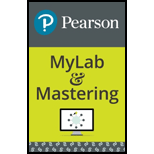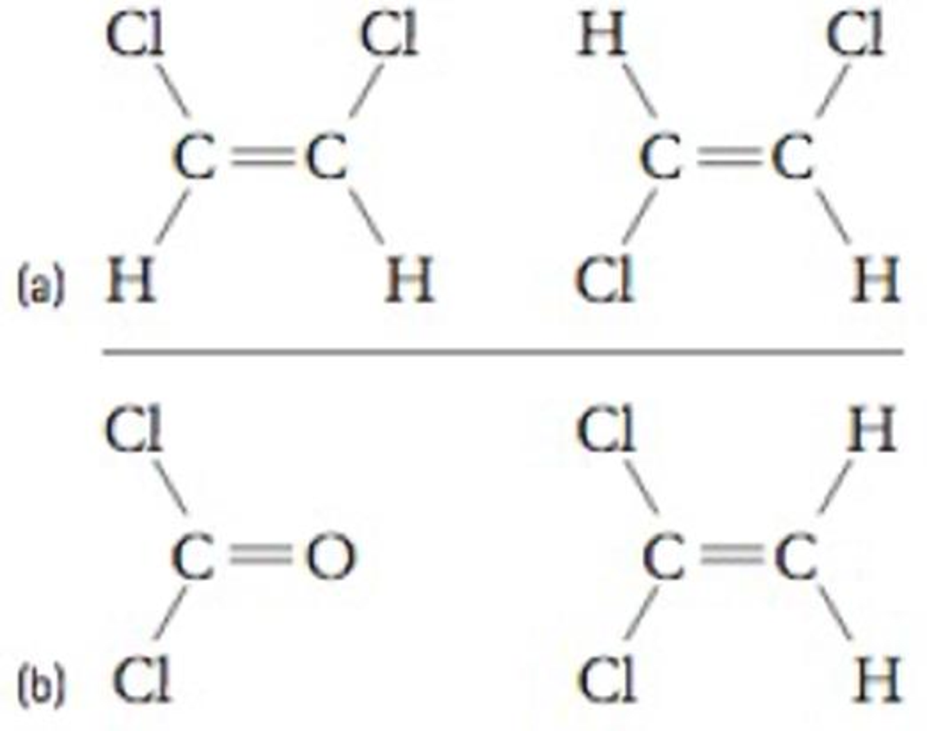
EP CONCEPTUAL PHYSICAL SCI.-MOD.MASTER.
6th Edition
ISBN: 9780134091983
Author: Hewitt
Publisher: PEARSON CO
expand_more
expand_more
format_list_bulleted
Textbook Question
Chapter 15, Problem 68E
In the figure on the next page, the molecule from each pair that should have a higher boiling point. (Atomic numbers: Cl = 17; O = 8; C = 6; H =1)

Expert Solution & Answer
Want to see the full answer?
Check out a sample textbook solution
Students have asked these similar questions
Car A starts from rest at t = 0 and travels along a straight road with a constant acceleration of 6 ft/s^2 until it reaches a speed of 60ft/s. Afterwards it maintains the speed. Also, when t = 0, car B located 6000 ft down the road is traveling towards A at a constant speed of 80 ft/s. Determine the distance traveled by Car A when they pass each other.Write the solution using pen and draw the graph if needed.
In the given circuit the charge on the plates of 1 μF capacitor, when 100 V battery is connected to the terminals
A and B, will be
2 μF
A
1 µF
B
3 µF
The velocity of a particle moves along the x-axis and is given by the equation ds/dt = 40 - 3t^2 m/s. Calculate the acceleration at time t=2 s and t=4 s. Calculate also the total displacement at the given interval. Assume at t=0 s=5m.Write the solution using pen and draw the graph if needed.
Chapter 15 Solutions
EP CONCEPTUAL PHYSICAL SCI.-MOD.MASTER.
Ch. 15 - How many electrons can occupy the first shell? How...Ch. 15 - Which electrons are represented by an electron-dot...Ch. 15 - Prob. 3RCQCh. 15 - How does an ion differ from an atom?Ch. 15 - To become a negative ion, does an atom lose or...Ch. 15 - Why does the fluorine atom tend to gain only one...Ch. 15 - Prob. 7RCQCh. 15 - Suppose an oxygen atom gains two electrons to...Ch. 15 - Prob. 9RCQCh. 15 - Do metals more readily gain or lose electrons?
Ch. 15 - What is an alloy?Ch. 15 - What is a native metal?Ch. 15 - Prob. 13RCQCh. 15 - Prob. 14RCQCh. 15 - Within a neutral molecule, how many covalent bonds...Ch. 15 - Prob. 16RCQCh. 15 - Prob. 17RCQCh. 15 - Prob. 18RCQCh. 15 - Prob. 19RCQCh. 15 - How can a molecule be nonpolar when it consists of...Ch. 15 - Why do nonpolar substances boil at relatively low...Ch. 15 - Which is more symmetrical: a polar molecule or a...Ch. 15 - Why dont oil and water mix?Ch. 15 - Prob. 24RCQCh. 15 - Which is stronger: the ion-dipole attraction or...Ch. 15 - What is a hydrogen bond?Ch. 15 - Are induced dipoles permanent?Ch. 15 - Prob. 31TASCh. 15 - What is the electric charge on the calcium ion in...Ch. 15 - Prob. 33TASCh. 15 - Prob. 34TASCh. 15 - Rank these bonds in order of increasing polarity:...Ch. 15 - Prob. 36TARCh. 15 - Prob. 37TARCh. 15 - Prob. 38TARCh. 15 - Prob. 39ECh. 15 - Prob. 40ECh. 15 - How many more electrons can fit within the valence...Ch. 15 - Prob. 42ECh. 15 - What happens when hydrogens electron gets close to...Ch. 15 - Prob. 44ECh. 15 - Why does an atom with few valence electrons tend...Ch. 15 - Why is it so easy for a magnesium atom to lose two...Ch. 15 - Why doesnt the neon atom tend to lose or gain any...Ch. 15 - Why does an atom with many valence electrons tend...Ch. 15 - Sulfuric acid, H2SO4, loses two protons to form...Ch. 15 - Prob. 50ECh. 15 - Which should be more difficult to pull apart: a...Ch. 15 - Prob. 52ECh. 15 - Given that the total number of atoms on our planet...Ch. 15 - An artist wants to create a metal sculpture using...Ch. 15 - Two fluorine atoms join together to form a...Ch. 15 - How are metallic bonds similar to ionic bonds? How...Ch. 15 - What drives an atom to form a covalent bond: its...Ch. 15 - Atoms of nonmetallic elements form covalent bonds,...Ch. 15 - Prob. 59ECh. 15 - Prob. 60ECh. 15 - Write the electron-dot structure for the covalent...Ch. 15 - Prob. 62ECh. 15 - In each molecule, which atom carries the greater...Ch. 15 - Which is more polar: a sulfur-bromine (S-Br) bond...Ch. 15 - True or False: The greater the nuclear charge of...Ch. 15 - True or False: The more shells in an atom, the...Ch. 15 - Water, H2O, and methane, CH4, have about the same...Ch. 15 - In the figure on the next page, the molecule from...Ch. 15 - Prob. 69ECh. 15 - Three kids sitting equally apart around a table...Ch. 15 - Which is stronger: the covalent bond that holds...Ch. 15 - The charges with sodium chloride are all...Ch. 15 - Prob. 73ECh. 15 - Prob. 74ECh. 15 - Prob. 75ECh. 15 - A thin stream of water is pulled to a rubber...Ch. 15 - Prob. 77ECh. 15 - Prob. 1RATCh. 15 - Prob. 2RATCh. 15 - Which would you expect to have a higher melting...Ch. 15 - Why are ores so valuable? (a) They are sources of...Ch. 15 - In terms of the periodic table, is there an abrupt...Ch. 15 - A hydrogen atom does not form more than one...Ch. 15 - When nitrogen and fluorine combine to form a...Ch. 15 - Prob. 8RATCh. 15 - Prob. 9RATCh. 15 - Iodine, I2, has a higher melting point than...
Additional Science Textbook Solutions
Find more solutions based on key concepts
Choose the best answer to each of the following. Explain your reasoning. Saturns many moons affect its rings pr...
Cosmic Perspective Fundamentals
What were the major microbiological interests of Martinus Beijerinck and Sergei Winogradsky? It can be said tha...
Brock Biology of Microorganisms (15th Edition)
When working on barley plants, two researchers independently identify a short-plant mutation and develop homozy...
Genetic Analysis: An Integrated Approach (3rd Edition)
All of the following processes are involved in the carbon cycle except: a. photosynthesis b. cell respiration c...
Human Biology: Concepts and Current Issues (8th Edition)
2. A person’s heart rate is given in beats per minute. Is this a period or a frequency?
College Physics: A Strategic Approach (3rd Edition)
Identify each of the following reproductive barriers as prezygotic or postzygotic. a. One lilac species lives o...
Campbell Essential Biology with Physiology (5th Edition)
Knowledge Booster
Learn more about
Need a deep-dive on the concept behind this application? Look no further. Learn more about this topic, physics and related others by exploring similar questions and additional content below.Similar questions
- The velocity of a particle moves along the x-axis and is given by the equation ds/dt = 40 - 3t^2 m/s. Calculate the acceleration at time t=2 s and t=4 s. Calculate also the total displacement at the given interval. Assume at t=0 s=5m.Write the solution using pen and draw the graph if needed.arrow_forwardThe velocity of a particle moves along the x-axis and is given by the equation ds/dt = 40 - 3t^2 m/s. Calculate the acceleration at time t=2 s and t=4 s. Calculate also the total displacement at the given interval. Assume at t=0 s=5m.Write the solution using pen and draw the graph if needed. NOT AI PLSarrow_forwardThe velocity of a particle moves along the x-axis and is given by the equation ds/dt = 40 - 3t^2 m/s. Calculate the acceleration at time t=2 s and t=4 s. Calculate also the total displacement at the given interval. Assume at t=0 s=5m.Write the solution using pen and draw the graph if needed.arrow_forward
- The velocity of a particle moves along the x-axis and is given by the equation ds/dt = 40 - 3t^2 m/s. Calculate the acceleration at time t=2 s and t=4 s. Calculate also the total displacement at the given interval. Assume at t=0 s=5m.Write the solution using pen and draw the graph if needed.arrow_forwardPlease don't use Chatgpt will upvote and give handwritten solutionarrow_forwardNo chatgpt pls will upvote Already got wrong chatgpt answerarrow_forward
- An electron and a proton are each accelerated through a potential difference of 21.0 million volts. Find the momentum (in MeV/c) and the kinetic energy (in MeV) of each, and compare with the results of using the classical formulas. Momentum (MeV/c) relativistic classical electron proton Kinetic Energy (MeV)arrow_forwardFour capacitors are connected as shown in the figure below. (Let C = 20.0 µF.) (a) Find the equivalent capacitance between points a and b. µF (b) Calculate the charge on each capacitor, taking ΔVab = 14.0 V. 20.0 µF capacitor µC 6.00 µF capacitor µC 3.00 µF capacitor µC capacitor C µCarrow_forward11. At what point in SHM is the velocity maximum? Displacement maximum?arrow_forward
arrow_back_ios
SEE MORE QUESTIONS
arrow_forward_ios
Recommended textbooks for you
 University Physics Volume 3PhysicsISBN:9781938168185Author:William Moebs, Jeff SannyPublisher:OpenStax
University Physics Volume 3PhysicsISBN:9781938168185Author:William Moebs, Jeff SannyPublisher:OpenStax Physics for Scientists and Engineers with Modern ...PhysicsISBN:9781337553292Author:Raymond A. Serway, John W. JewettPublisher:Cengage Learning
Physics for Scientists and Engineers with Modern ...PhysicsISBN:9781337553292Author:Raymond A. Serway, John W. JewettPublisher:Cengage Learning Modern PhysicsPhysicsISBN:9781111794378Author:Raymond A. Serway, Clement J. Moses, Curt A. MoyerPublisher:Cengage Learning
Modern PhysicsPhysicsISBN:9781111794378Author:Raymond A. Serway, Clement J. Moses, Curt A. MoyerPublisher:Cengage Learning An Introduction to Physical SciencePhysicsISBN:9781305079137Author:James Shipman, Jerry D. Wilson, Charles A. Higgins, Omar TorresPublisher:Cengage Learning
An Introduction to Physical SciencePhysicsISBN:9781305079137Author:James Shipman, Jerry D. Wilson, Charles A. Higgins, Omar TorresPublisher:Cengage Learning Glencoe Physics: Principles and Problems, Student...PhysicsISBN:9780078807213Author:Paul W. ZitzewitzPublisher:Glencoe/McGraw-Hill
Glencoe Physics: Principles and Problems, Student...PhysicsISBN:9780078807213Author:Paul W. ZitzewitzPublisher:Glencoe/McGraw-Hill


University Physics Volume 3
Physics
ISBN:9781938168185
Author:William Moebs, Jeff Sanny
Publisher:OpenStax

Physics for Scientists and Engineers with Modern ...
Physics
ISBN:9781337553292
Author:Raymond A. Serway, John W. Jewett
Publisher:Cengage Learning

Modern Physics
Physics
ISBN:9781111794378
Author:Raymond A. Serway, Clement J. Moses, Curt A. Moyer
Publisher:Cengage Learning

An Introduction to Physical Science
Physics
ISBN:9781305079137
Author:James Shipman, Jerry D. Wilson, Charles A. Higgins, Omar Torres
Publisher:Cengage Learning

Glencoe Physics: Principles and Problems, Student...
Physics
ISBN:9780078807213
Author:Paul W. Zitzewitz
Publisher:Glencoe/McGraw-Hill
The Laws of Thermodynamics, Entropy, and Gibbs Free Energy; Author: Professor Dave Explains;https://www.youtube.com/watch?v=8N1BxHgsoOw;License: Standard YouTube License, CC-BY